Introduction to LWC Interview Questions
Salesforce technologies are always evolving, and the demand for competent experts appears to never end, so whether you’re new to Salesforce development or a seasoned veteran like SasSy, one thing remains constant when looking for your next job: acing the job interview.
Going into a job interview with a decent understanding of the platform (which should, of course, deepen depending on the role’s seniority!) is a terrific approach to obtain an edge over other candidates. Below is a list of questions I’ve used in the past when interviewing applicants of all skill levels, which I’m releasing in the hopes of helping anyone who is considering a technical interview better understand the types of questions and expectations that may be present.
However, because the Salesforce world is heading towards Lightning Web Components (LWC interview questions), I’m going to provide some Lightning Web Components (LWC Interview Questions) today. These questions range from fundamental to advanced, and they will be beneficial to everyone.
What Is LWC?
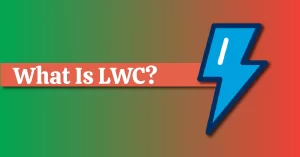
LWC is a new programming approach that takes advantage of the latest web standards. It is quite flexible, rather than being a completely unique and development-wise strict framework. To make it a perfect fit for Modern Rich UI Implementations in Salesforce, it largely consists of standard Web Standards and a Thin Layer of Specialized Services. Base Lightning Components, Lightning Data Service, and User Interface API are all part of this thin layer of specialized services that work behind the scenes for LWC interview questions.
LWC (Lightweight Web Components) is a collection of modern lightweight frameworks based on current web standards. It’s a DOM (Document Object Model) element that uses reusable code to construct a dynamic interface without the need for JavaScript or the creation of a library.
Lightning Web Components adhere to fundamental Web Components standards and only supply what’s required to work in Salesforce-supported browsers. Lightning Web Components is lightweight and performs well since it is built on code that runs natively in browsers. The majority of the code you write is JavaScript and HTML. You will learn more about LWC in our blog of LWC interview questions.
Salesforce Lightning is an application development platform that helps corporate users streamline their processes. The Lightning Experience is a sophisticated user interface with the most up-to-date features and pages for optimizing and developing your business. Lightning includes all of the technology and tools required to maintain the Salesforce platform. Because of its out-of-the-box component set and extensive ecosystem, salesforce lightning is used by a number of well-known companies, like Adidas, Cisco Systems, Motorola Inc, and Allianz AG, to complete their corporate operations and strengthen customer connections. As a result, certified salesforce lightning professionals have multiple work options all across the world.
Salesforce is a member of the World Wide Web Consortium and is dedicated to the development of open web standards (W3C). Salesforce developers contribute to the Ecma International Technical Committee 39 (TC39), which is in charge of JavaScript development. This is among the most basic LWC Interview Questions that an interviewer can ask.
Benefits
On top of a basic web stack, a thin layer of specialized services yields:
- Large-scale modular apps should be easy to develop.
- Utilization of the most recent web capabilities and constructions is simple.
- A common model and skills that can be transferred
- (Any web developer using recent JS frameworks could quickly learn LWC.)
- Components that work together.
- Improved performance.
LWC Interview Questions & Answers For Freshers
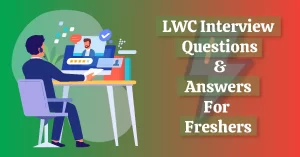
What are Lightning Web Components and How Do I Use Them?
Lightning Web Components and Aura Components are two programming models that can be used to create Lightning components. Custom HTML elements created with HTML and contemporary JavaScript are known as Lightning web components. On a page, Lightning web components and Aura components can coexist and work together. Both appear as Lightning components to admins and end users.
Lightning Web Components adhere to fundamental Web Components standards and only supply what’s required to work in Salesforce-supported browsers. Lightning Web Components is lightweight and performs well since it is built on code that runs natively in browsers. The majority of the programming we create is JavaScript and HTML. You will discover more about LWC in our blog of LWC interview questions.
In LWC, how can we bind data?
Surround the property, property, with curly brackets in the template. Use get property(), a JavaScript getter in the JavaScript class, to compute a value for the property. A JavaScript identifier (for example, person) or dot notation that accesses a property from an object can be used in the template (person.firstName). Computed phrases, such as person[2], are not permitted in LWC. name[‘John’].
Hello, {greeting}!
// hello.js
import { LightningElement } from ‘lwc’;
export default class Hello extends LightningElement {
greeting = ‘World’;
}
Adding spaces around the property, such as data, is not valid HTML.
Is it possible to use LWC JS to call a third-party API?
We can’t connect to WebSockets or call third-party APIs from JavaScript code by default. Add a distant site as a CSP Trusted Site to accomplish this.
Material Security Policy (CSP), a W3C standard, is used by the Lightning Component architecture to limit the source of content that can be loaded on a page. As a result, API calls from JavaScript code are not permitted under the default CSP policy. By adding CSP Trusted Sites, you can change the policies and the content of the CSP header.
How can we change the body of a component after it has been rendered?
RenderCallback() is only available in Lightning Web Components. After a component has completed the rendering step, use it to perform logic.
This hook is passed on from father to child. During the life of an application, a component is frequently rendered multiple times. Use a boolean property like hasRendered to track if renderedCallback() has been run when using this hook to conduct a one-time operation. So, when renderedCallback() is called for the first time, conduct the one-time operation and set hasRendered = true. Don’t do the procedure if hasRendered = true. Interviewer can ask you these LWC Interview Questions to test your knowledge of renderedCallback().
What are the Decorators in LWC
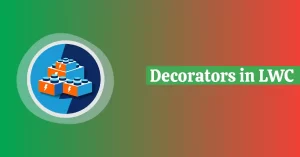
- @api
The public realm is reactive. The component re-renders if the value of a public property changes. Decorate a field with @api to expose a public property. A component’s API is defined by its public attributes.
Decorate a public method with @api to make it public. The API of a component includes public methods. Owner and parent components can call JavaScript methods on child components to communicate along the containment h
ierarchy.
- @track
Fields have a reactive nature. If the value of a field changes when the field is utilized in a template or a getter of a template’s property, the component redraws and displays the new value.
@track has only one application. When a field contains an object or an array, the depth of changes that can be recorded is limited. Decorate a field with @track to inform the framework to keep an eye on changes to an object’s properties or the elements of an array.
- @wire
Lightning web components employ a reactive wire service to read Salesforce data. The component re-renders when the wire service provides data. To provide a wire adapter or an Apex function, components use @wire in their JavaScript class. Interviewer can ask you these LWC Interview Questions to test your knowledge of decorators.
How can we get Current Experience Builder Site
We can use the @salesforce/community scoped module to import information about the current Experience Builder site.
- property—The following properties are supported:
- Id—The current site’s identifier.
- basePath—The base path is the section of the URL that follows the domain. The community’s URL is newstechnologystuff.force.com/lwcdemo/s if your site’s domain name is newstechnologystuff.force.com and lwcdemo was the URL value added when you built the site. The base route in this example is lwcdemo/s.
- propertyName—A name for the Experience Builder property that was imported. Interviewer can ask you these LWC Interview Questions to test your knowledge of current experience builder site.
Share all the supported Target for LWC
Experience Builder
- Set is Exposed to true to make your component usable in Experience Builder. Then add one of these numbers as a target in targets:
- lightningCommunity__Page_Layout to Create a component in the Components panel that you can drag and drop.
- To develop a page layout component for LWR sites that shows in the Content Layout window, use lightningCommunity Page Layout.
- lightningCommunity__Theme_Layout This will build a theme layout component for LWR sites, which will appear in the Theme area’s Settings.
- Define lightningCommunity Default in targets and define the properties in targetConfigs to add editable properties when the component is selected in Experience Builder. In Experience Builder, only properties created for the lightningCommunity Page or lightningCommunity Page Layout targets are modifiable.
Interviewer can ask you these LWC Interview Questions to test your knowledge of supported target.
What exactly do you mean when you say “cacheable = true annotations”?
First and foremost, when a function is marked as cacheable = true, it can only retrieve data and cannot perform any DML.
It’s used to boost component performance by displaying cached data from client-side storage without having to go to the server. Because LDS does not control data coming from Apex, we must utilize refreshApex to refresh the stale data given by Apex ( In case of wired service). Interviewer can ask you these LWC Interview Questions to test your knowledge of cacheable.
What are LWC’s lifecycle hooks?
A lifecycle hook is a callback method that is triggered at a certain point in the lifecycle of a component instance.
In LWC interview questions, the following hooks are supported:
- Constructor : When the component is formed, the function Object() { [native code] } is called.
- Connectedcallback : When the element is put into a document, the connectedcallback method is called. This hook is passed down the line from parent to child.
- RenderedCallback: Called after each component rendered. This lifetime hook isn’t part of the HTML custom elements definition; it’s exclusive to Lightning Web Components. This hook is passed on from father to child. It is specified in LightningElement rather than HTMLElement.
- Disconnectedcallback : When an element is deleted from a document, the Disconnectedcallback is triggered. This hook is passed down the line from parent to child.
- Errorcallback :When a descendant component throws an error, Errorcallback is called. The stack argument is a string, and the error argument is a JavaScript native error object. This lifetime hook isn’t part of the HTML custom elements definition; it’s exclusive to Lightning Web Components.
Interviewer can ask you these LWC Interview Questions to test your knowledge of LWC’s lifecycle hooks. This is also among the most basic LWC Interview Questions that an interviewer can ask.
How can I reference the record ID of the page in my component which is fired from quick action?
In LWC interview questions, there are two categories of rapid actions:
Screen actions: Any action that opens a modal window.
Headless actions : Headless actions are those that don’t have an html file and instead rely on js logic, so no modal window will appear.
We may access recordID from screen actions by simply specifying recordID as a public property in the component. You must define a @api invoke method that is auto invoked for headless activity, and recordID will be set once this function is called. Interviewer can ask you these LWC Interview Questions to test your knowledge of quick action.
LWC Interview Questions & Answers For Experienced
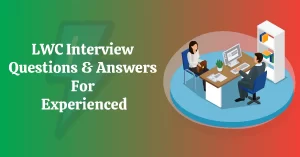
What are web components, and is LWC built on them?
In the simplest terms, web components allow you to develop and reuse bespoke components as html elements within a component, with their functionality isolated from the rest of your code.
Web components are supported by four pillars that make them so powerful.
- HTML Template :User-defined HTML templates are rendered until they are called upon.
- Custom Elements: We may use this to add components to our template that are simply html tags.
- Shadow DOM: This allows us to segregate the DOM of each custom element from the DOM of other components, ensuring that nothing from one component leaks into another.
- HTML Imports: You can import other html documents into another html document. For example, we can import many templates into one component and then show them using the render method.
Yes, LWC is built on the basis of web components.
Salesforce simply adds security, LDS, and base components to the LWC architecture; the rest is built on web components and es 7. Interviewer can ask you these LWC Interview Questions to test your knowledge of web components. This is also among the most basic LWC Interview Questions that an interviewer can ask.
What is the Lightning Web Components file structure?
- myComponent folder
- myComponent.html
- myComponent.js
- myComponent.js-meta.xml
- myComponent.css
- myComponent.svg
These naming conventions must be followed by the folder and its files.
- A hyphen isn’t allowed (dash)
- It has to start with a lowercase letter.
- There isn’t any room for whitespace.
- Only alphanumeric or underscore characters are allowed.
- It’s impossible to end with an underscore.
- In the names
pace, it must be unique. - There can’t be two underscores in a row.
Interviewer can ask you these LWC Interview Questions to test your knowledge of file structure.
What is Reusability in LWC interview questions?
We will be able to access the value from one method to another method.
method1:
function(component){var name=’sfdcscenarios’;this.method2(name);
},
method2:
function(name){//reusabilityconsole.log(‘name from method1 is’+name);}
Interviewer can ask you these LWC Interview Questions to test your knowledge of reusability element in LWC.
What are the benefits of using lightning?
An out-of-the-box set of components, event-driven design, and a performance-optimized framework are among the advantages.
- Out-of-the-Box Component Set -: Includes a pre-installed set of components to get you started constructing apps right away. You won’t have to waste time optimizing your apps for various devices because the components will do it for you. Create business-ready components and make them available in Salesforce1, Lightning Experience, and Communities through a rich component ecosystem.
- Performance –:It efficiently utilizes your server, browser, devices, and network so you can focus on the logic and interactions of your apps. It uses a stateful client and stateless server architecture that relies on JavaScript on the client side to handle UI.
- Event-driven architecture -: an event-driven architecture that allows components to be decoupled more easily.
- Faster development — Empowers teams to work more efficiently using out-of-the-box components that work across desktop and mobile platforms.
- Device-aware and cross browser compatibility – Responsive design, which supports the newest browser technology such as HTML5, CSS3, and touch events, as well as device-aware and cross-browser compatibility.
Interviewer can ask you these LWC Interview Questions to test your knowledge of benefits of lightning. This is also among the most basic LWC Interview Questions that an interviewer can ask.
What are the places where we can use Lightning Components?
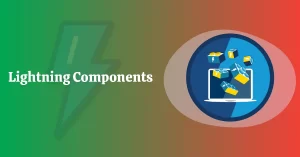
Use lightning components in the places listed below:
- In the lightning app builder and community builder, you can drag & drop components.
- Lightning components can be added to lightning pages.
- On the lightning experience record pages, add the lightning component.
- As a rapid action, launch a lightning component.
- Lightning components can be used to override conventional actions.
- Make stand-alone applications.
Interviewer can ask you these LWC Interview Questions to test your knowledge of lightning components.
What are the various programming models available for creating lightning components? Explain them.
There are two alternative programming models for Lightning components. The first option is to utilize the Aura framework to create Aura components, and the second option is to use the newer Lightning Web Components (LWC) framework.
- Aura Framework: Aura is a user interface framework for developing dynamic web apps for mobile and desktop devices, with a scalable long-lived lifecycle that enables the creation of growth-oriented apps. It enables the building of multi-tier partitioned components that connect the client and server.
Aura, which has been around since 2013, allows developers to construct apps that aren’t reliant on Salesforce data, resulting in less disruption for consumers on a day-to-day basis. Aura provides for more efficient development because applications don’t have to be optimized for each device. - Lightning Web Components Framework: Lightning Web Components is an implementation of the W3C Web Components standard. It merely adds what’s required to work in all Salesforce-supported browsers and supports the elements of Web Components that perform well in browsers. You will get more familiar with this topic in our LWC interview questions
It’s a set of advanced lightweight frameworks based on the latest web standards. It’s a code-based document object model element that can be reused. It’s used to develop complex interfaces without the requirement for JS or a library. This feature makes it easier to use and faster, saving time and effort on the web stack for developers. Interviewer can ask you these LWC Interview Questions to test your knowledge of programming models.
What Advantages do the Lightning Web Components (LWC) have over the Aura components?
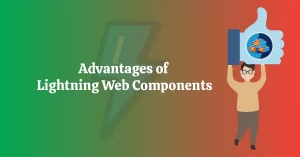
Only those working behind the scenes can see the difference between the Lightning Web Components and the Aura Components. Salesforce and the community, on the other hand, strongly advise developers to use LWCs when creating SPAs for the following reasons:
- Simple to Use: LWC fills out the form using the browser’s native web standards. This means we don’t need an extra distraction layer like Aura Framework or another framework; all we need is plain JavaScript.
- Higher Performance: In the lack of an abstraction layer, LWC is likely to render faster than the aura components, which is important for deliverability.
- Sites Load More Quickly: LWC is a lightweight framework that quickly loads built-in components.
- Less proprietary, more standards: Out-of-the-box modification is becoming less prevalent as LWC has built-in browser security measures from Web Components Standards.
- UI: Components with no/little UI can be developed in LWC and reused in other components, making them more efficient than static resources.
- Easy to Learn for Developers: Developers will find it simple to learn: In order to build LWC, you don’t need to master any other framework. As a result, the developers will have a more straightforward experience.
- Improved security, testing, and browser compatibility: LWC improves script, CSS, and DOM isolation, and event scope is constrained. With each of them, we have more consistency in the component design. Furthermore, LWC supports two-way data binding, allowing us to coordinate the flow of data between different components. Interviewer can ask you these LWC Interview Questions to test your knowledge of advantages of LWC.
Explain how Aura and the Lightning Web Framework, two programming models, coexist?
The Aura and LWC components can be mixed and matched. Aura is the ultimate parent component. Auras have both Lightning Web Components and Aura components, whereas Lightning Web Components only have their own component.
When Aura and LWC components are included within a parent, they can interact in a variety of ways, including:
- To interact directly with the child component, use application and component events.
- JS CustomEvent objects are used to receive data and interact with child component functions and attributes supplied through public APIs.
- Both the Aura components and the LWC may receive and transport data via the Lightning Data Service (LDS). There is presently no way for Aura and Lightning web components that are not in the same hierarchy to communicate.
Interviewer can ask you these LWC Interview Questions to test your knowledge of aura and LWC.
What do you understand about Lightning Data Service (LDS) in the context of Salesforce Lightning?
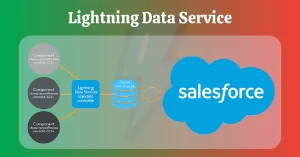
Without requiring Apex code, Lightning Data Service (LDS) is utilized to create, delete, update, and load records in our component. Lightning Data Service is in charge of security and sharing regulations at the field level. The Lightning Data Service improves productivity and user interface consistency while also making Salesforce data more accessible.
Lightning Data Service is the Lightning components’ equivalent of the Visualforce standard controller at its most basic level. While overstated, this phrase serves to emphasize a point. Wherever possible, use Lightning Data Service to access and modify Salesforce data in your components. Interviewer can ask you these LWC Interview Questions to test your knowledge of LDS.
In the context of Salesforce Lightning, what do you mean by bound and unbound expressions?
- Bound Expression: The symbol for bound expression {!v.str}. This expression will reflect any changes in the string’s value as well as the components where it is used, therefore we can say that the value changes dynamically through this expression.
- Unbound Expression: The symbol for unbound expression is {#v.str}. This expression will not modify the string’s value; in fact, we may argue that the value will remain unchanged as a result of this expression.
Interviewer can ask you these LWC Interview Questions to test your knowledge of bound and unbound expressions.
Conclusion
Lightning Web Components, which offer the latest web standards, enable remarkable performance and productivity, and interoperate smoothly with current code, are the greatest time to learn and start early. Every Salesforce developer wants to get their hands on LWC and lightning components since they demand less training and allow them to create web apps using user-friendly standards-based technologies.
By 2024, the Salesforce ecosystem will have created 4.2 million employment, a 2.7x increase in job growth. As a result, now is the ideal time to invest your career in this field and secure your dream job using our LWC interview questions. Please do not hesitate to contact us if you have any queries regarding LWC interview questions.
Frequently Asked Question’s
1. What is LWC and why is it being used?
We need to figure out why Salesforce introduced LWC interview questions when the Aura Component framework was already available. We’ll need to go back to 2014 and take a look at the 2014 web stack for this.
Online standards only offered a limited foundation for the whole stack that developers need to build large-scale web applications in 2014, when the Lightning Components framework(LWC interview questions) and the Aura programming model were released, i.e. a rendering engine, standard components, events, and a core language (ECMAScript 5). The web standards are lacking crucial aspects like a component model, templates, modules, and shadow DOM. Let’s move on to the next faq for LWC Interview Questions blog.
The Lightning Web Components Framework (LWC) is a new programming approach for creating Salesforce lightning components. It’s a user interface framework developed with native HTML and contemporary JavaScript. It leverages custom elements, templates, decorators, modules, shadow DOM, and other new language structures available in ECMAScript 7 and beyond, as well as basic web component standards.
Previously, the aura component framework could be used to create lightning components. We now have a new framework to work with in order to create the same lightning components. Our blog of LWC interview questions will help you to get you more familiar with this topic. Let’s move on to the next faq for LWC Interview Questions blog.
3. What are the benefits of LWC?
- Easy to Learn: LWC is simple to learn because it takes the shape using native web standards in the browser. It means that we don’t need any additional abstraction layers like Aura Framework or any other framework to create; all we need is ordinary JavaScript.
- Better Performance: Because there is no additional abstraction layer, LWC is likely to render faster than aura components, which is crucial for deliverability.
- Faster loading sites: Like lightning, LWC loads generated components faster than Aura Components and is a lightweight framework based on web standards.
Let’s move on to the next faq for LWC Interview Questions blog.
4. What is the difference between lightning and LWC?
Aura-based HTML and JavaScript are used to create Lightning components, whereas LWC is based entirely on the Web stack. A developer working on LWC is not only applying coding abilities in one framework, but also in other frameworks based on the Web Stack, such as React or Angular. You will learn more about lightning web components in this blog of lwc interview questions. Let’s move on to the next faq for LWC Interview Questions blog.
5. How do I start learning LWC?
- The LWC Video Gallery might help you learn more about LWC.
- Install VS Code and configure it to work with Salesforce.
- Here you’ll find easy-to-understand sample code for practically all usage situations.
- More samples can be found here.
- Create your own LWC and test it by running it.
Let’s move on to the next faq for LWC Interview Questions blog.
6. Which is better aura or LWC?
LWC is a lightweight framework built on web standards, and because there is no extra abstraction layer, LWC is likely to render faster than aura components, which is significant for deliverability. You will learn more about lwc in our blog of lwc interview questions
7. Why LWC is faster than aura?
The Lightning web component script is written in HTML and Javascript. As a result, chores are easier to complete. Because LWC is based on web components, it is incredibly lightweight and memory efficient. LWC is much faster than Aura lightning components because of this. LWC is substantially easier to debug than ALC. Various Salesforce discussion forums promptly answer and execute the step-by-step debugging concerns. Let’s move on to the next faq for LWC Interview Questions blog.
8. What are limitations of LWC?
The limitations are as follows:
- You can’t utilize a LWC for Actions yet, and the LEX console isn’t supported currently.
- As a workaround, you can incorporate the LWC inside an Aura component.
- LWC, unlike Aura, does not support two-way data binding. As a result, user input is not sent back to the controller automatically.
- To account for this, I use a single change handler that copies the value of event.currentTarget.value to the controller property corresponding to event.currentTarget.name.
- LWC, unlike Aura, does not support two-way data binding. As a result, user input is not sent back to the controller automatically. The child component cannot change the @api properties handed down from the parent component. Let’s move on to the next faq for LWC Interview Questions blog.
9. What are decorators in LWC?
Because LWC is based on web components, it is incredibly lightweight and memory efficient. LWC is much faster than Aura lightning components because of this. Let’s move on to the next faq for LWC Interview Questions blog.
10. How do I access LWC in Salesforce?
Make a Web Component for Lightning.
- Open the Command Palette in Visual Studio Code by pressing Ctrl+Shift+P (Windows) or Cmd+Shift+P (Mac) (macOS).
- Type SFDX ..
- Select SFDX: Create Lightning Web Component from the drop-down menu.
- The name of the new component should be helloWorld.
- To accept the default force-app/main/default/lwc, press Enter.













